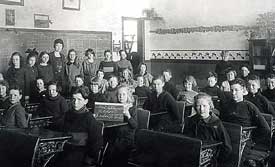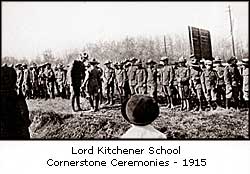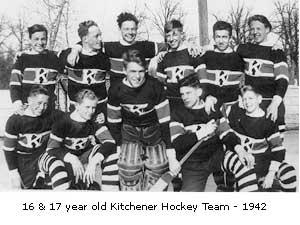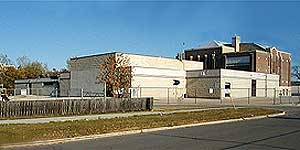ABOUT US
School History
The first school in what is now North Kildonan could have been operating as early as 1817 by John Pritchard, a Hudson Bay Company employee who was very likely the first settler in this municipality. It was a private school mainly for the sons of the Hudson Bay Company employees and was located in the Pritchard home on the east bank of the Red River on or near the present site of John Pritchard School at a place called "The Elms".
 In the 1843 Red River Census, it was mentioned that John Pritchard kept a school which had six pupils. His son, Samuel Pritchard moved the school to Middlechurch, and today is better known as St. John's College.
In the 1843 Red River Census, it was mentioned that John Pritchard kept a school which had six pupils. His son, Samuel Pritchard moved the school to Middlechurch, and today is better known as St. John's College.
Settlement flourished in the west and led to the Confederation of Canada in 1867, the creation of Manitoba in 1870, the development of Point Douglas into the City of Winnipeg in 1874, and the incorporation, in 1875, of the Municipality of Kildonan.
After Pritchard's school at "The Elms", the next school for those children living east of the Red River was Nesbitt Hall. This school was across the river, on the west side, right next to Kildonan Presbyterian Church. Together with the school at St. John's Church, also on the west side of the river, but a long way south, Nesbitt Hall took care of the area's educational needs from the 1850's to the 1880's. Both these schools, however, were a long way off and difficult to reach, so in 1881, a school was started in a two-room log cabin at what is today the corner of Henderson and McLeod. This log cabin, named Kildonan East School, operated until it couldn't provide enough space, and in 1908, East Kildonan School opened just north of McLeod Avenue at 1110 Henderson Highway. This two storey, yellow brick building served as a school for only seven years. This odd building, narrow but tall, stood out over the landscape like a grain elevator. It served as a school, municipal office (complete with jail cell), a soap producing plant, a church and a Sunday School building, a road house or night club under a variety of names (Kit Kat Inn, Coconut Grove, Brown Derby, Big Apple), a store and an apartment block. Eventually, it was pulled down in the 1960's.
In the mid 1890's, a new farmer moved in just south of Fortier and Henderson. Herbert Whellams purchased the former John Pritchard property, "The Elms". Whellams had grown up on a farm near Rapid City. When he moved to Winnipeg, he first purchased property in the Bronx Park area of East Kildonan. However, this seems to have been too close to the expanding urbanization of Winnipeg, for Mr. Whellams soon moved to the locally well-known estate on Lot 54, "The Elms". He established himself as a very successful market gardener, expanded the commercial side of market gardening by being one of the first to sign a contract with a pickling firm to supply them with produce, produced honey for W. H. Stone and Company, and was politically very active on municipal, provincial and federal levels. The road which ran through his property to the ferry site going over the river to the Kildonan Presbyterian Church is today called Whellams Lane - a tribute to this local leader.
During the 1900's and 1910's, Winnipeg expanded north and was experiencing a great boom in real estate sales. Thus, the streetcar line was extended out East Kildonan Road (Henderson Highway) as far as what is now known as Foxgrove Avenue. Sub division schemes were planned for the Rossmere region as well, but the North Kildonan area remained a farming district because it was too far away from the Winnipeg metropolis. Even the Bergen Cut-off, built in 1910 to "cut off" the necessity of all freight cars passing through downtown Winnipeg, did not help attract more residents.
A world-wide recession started in 1913; World War I started in 1914, and the Panama Canal was also opened, and this brought an end to the expansion in Winnipeg and put a stop to the flow of international investment money. Since the assumption was that both the war and the recession were only minor interruptions in the growth of Winnipeg, the school board decided to stay ahead of it all. They opened three large, new schools in 1915. Two were in the more heavily populated southern part of Kildonan, and the third one, Lord Kitchener School, was built at an initial cost of $75,000 on the land purchased in 1912 from Herbert Whellams. It was an imposing, three-storey, red brick structure, the severity of its lines softened by its ornamental stonework. It contained five classrooms, two basements and three entrances. The first caretaker, Mr. F. Nelson, originally lived in Room 8 on the second floor. Cooking was not allowed in the room, however, and had to be done downstairs in the staff room.
 Lord Kitchener School opened its doors on September 1, 1915, with one class of forty pupils in grades I to IV, under the instruction of Miss Daisy Jackson who also served as principal. Among other things, it was alleged that trustees had put a school where it wasn't needed because there weren't enough pupils in the district. There may have been some truth to this charge, for after being opened for 1915-1916, the School Board decided to close the school the next winter because of insufficient enrollment. Pupils went one mile south to Lord Wolsely School, but so much damage was incurred through frozen pipes and other forms of neglect in one year, that the school was reopened the following year.
Lord Kitchener School opened its doors on September 1, 1915, with one class of forty pupils in grades I to IV, under the instruction of Miss Daisy Jackson who also served as principal. Among other things, it was alleged that trustees had put a school where it wasn't needed because there weren't enough pupils in the district. There may have been some truth to this charge, for after being opened for 1915-1916, the School Board decided to close the school the next winter because of insufficient enrollment. Pupils went one mile south to Lord Wolsely School, but so much damage was incurred through frozen pipes and other forms of neglect in one year, that the school was reopened the following year.
The school was named Lord Kitchener School since it was built at the beginning of World War I and Lord Kitchener was Britain's Secretary of State for War. In 1925, a petition was granted, to divide Kildonan East, and thus East Kildonan and North Kildonan came into being, and the North Kildonan School District was formed. The resulting municipality was a large, rural based community with a population of close to 1100. The majority lived towards the river, but farms were scattered all through this new community called North Kildonan. Henderson Highway was paved, but not enough to give the appearance of a town centre. It was billed as "the country place close to town". Enrollment at Lord Kitchener school in Grades I to VIII had increased to 170 pupils in 1928, at which time Daisy Jackson retired as a teacher, and who had already given up her principal position two years earlier. Mr. H. H. Hooper was appointed principal of Lord Kitchener School in 1926 at a salary of $1300 per annum and held that position until retirement in 1956.
An interesting fact found in the minutes of School Board meetings tells us that the beautiful semi-circle of elm trees in front of Lord Kitchener was supplied in 1927 by Mr. Herbert Whellams, and planted by the caretaker for which he was paid $1.50. At that time the School District budget was $19,400 for the year.
In 1925, a tornado blew off part of the roof of Lord Kitchener School but the damage was easily repaired.
Starting in 1928, but mostly in the 1930's, Mennonites arrived in Winnipeg. Some wanted to form a Mennonite community close to Winnipeg, so bought land on Lots 59, 63 and 64, or Edison and McKay Avenues and Cheriton and Devon Avenues. This land was divided into thirty building lots and a Mennonite community grew in the area.
The Depression was also a big part of the 1930's, and with it came very difficult financial times. The rural life was an advantage though for residents of North Kildonan, and while other municipalities were declaring bankruptcy, North Kildonan's councillors and trustees were proud to boast that they had never had to borrow from the banks.
 The 1940's were a mixture of both hard times and good times. World War II had started in 1939, and many residents of the area went overseas to fight, and, as everywhere, the uncertainty of that situation was hard on the families back home. Rationing added to the difficulties. But there was a constant market for the produce from the North Kildonan farms, and some of that produce was even shipped overseas to Britain. All in all, the war years were a time of tension and the enormous celebrations of VE Day and VJ Day were truly heartfelt.
The 1940's were a mixture of both hard times and good times. World War II had started in 1939, and many residents of the area went overseas to fight, and, as everywhere, the uncertainty of that situation was hard on the families back home. Rationing added to the difficulties. But there was a constant market for the produce from the North Kildonan farms, and some of that produce was even shipped overseas to Britain. All in all, the war years were a time of tension and the enormous celebrations of VE Day and VJ Day were truly heartfelt.
Another misfortune took place in Lord Kitchener School in 1949 when the boiler exploded, leaving a conspicuous hole in the ceiling of the furnace room. Also in 1949, as a result of a dispute, the municipality was divided into two school districts: North Kildonan School District No. 2116, of which Lord Kitchener was a part, and McIvor School District.
The Winnipeg economy took off after the Second World War. The Curtis Hotel, the Rossmere Shopping Centre and the Rossmere Golf and Country Club were signs of growth in the area. The returning soldiers wanted to establish homes and families, and North Kildonan became an attractive suburbia. To accommodate the increase in population, a three-room addition occurred at Lord Kitchener School. North Kildonan had its most rapid growth during the building boom that began in the 1950's. Land was subdivided and new homes and apartments were built in gradually increasing numbers culminating in the Springfield Heights area, where several hundred acres of bluff and pasture were transformed into street after street of new homes. During this time, two additions were completed at Lord Kitchener: a 4-room structure known as Building #2 was added in 1953, and another three rooms to Building #2 were again added in 1956, at which time Mr. Hooper retired. Mr. Helgason succeeded Mr. Hooper as principal from 1956-1959, Mr. McGill from 1959 to 1960.
 Disagreement with the North Kildonan School District Board resulted in its dissolution in 1954, and school affairs were conducted for the next two years by an Official Trustee appointed by the Department of Education. In 1959, the River East Collegiate was built and served as a high school for residents in the surrounding area.
Disagreement with the North Kildonan School District Board resulted in its dissolution in 1954, and school affairs were conducted for the next two years by an Official Trustee appointed by the Department of Education. In 1959, the River East Collegiate was built and served as a high school for residents in the surrounding area.
The whole of North Kildonan and Henderson Highway was earmarked for residential development, and by the 1960's, the dairy farms and market gardens that had made up the rural nature of the community, were gone. The Disraeli Freeway was opened in 1960, and was counted as one of the main reasons for the continued expansion of North and East Kildonans. North Kildonan became urban and subdivisions were opened north of Oakland, east of Henderson, between Henderson and the river, and further east towards the tracks. Five more schools were built to accommodate the growing population. Mr.. V. Neufeld was appointed principal in 1960 and held that position until 1986, when he retired. Lord Kitchener School was allowed to celebrate its 50th Anniversary in 1965.
In 1967, a large addition was built to Lord Kitchener School, including a two-storey wing of classrooms (now known as Manitoba Hall), a large gymnasium/auditorium (Manitoba Gym), and Audio-Visual room (now the Office). About this time the School Board changed the name of the school to John Pritchard School. Some residents agreed with this move. After all, the school was put up on land that had originally belonged to John Pritchard, the man who started the education system in Kildonan. Others felt that Lord Kitchener School had established its own history through its war heroes and veterans, and the old name should have remained for second generation students.
By the time the amalgamation of the Greater Winnipeg area took place in 1972 under Unicity, the population of North KIldonan was almost 20,000. There was very little wilderness left, but parts were at least still open. For the rest, it was a bedroom community for Winnipeg, since most of the residents lived here but worked in other parts of the city.
In 1975, yet another addition was built, consisting of two science rooms and a lab, Industrial Arts shop, Music room, multi-purpose room and custodian's room. At this time, Mr. R. V. Purvis was principal, while Mr. Neufeld spent two years with the Department of National Defence in Lahr, Germany. During this time, North Kildonan acquired the Safeway/K-Mart Shopping Centre and McDonald's restaurant at the corner of Henderson and Whellams.
 Once again an addition was added, in 1985, this time a primary wing named Jackson Hall, in honor of Daisy Jackson, the first principal. This ended the need for classrooms in Building #2 and it became a storage area for the Maintenance Department.
Once again an addition was added, in 1985, this time a primary wing named Jackson Hall, in honor of Daisy Jackson, the first principal. This ended the need for classrooms in Building #2 and it became a storage area for the Maintenance Department.
The ending of the decade also saw the retirement of two very dedicated employees, namely Principal H. V. Neufeld in 1986, and Mrs. Alda Burton, secretary for 38 years, in 1989.
Mr. H. Kojima served as principal for three years, 1986-1989. In May of 1989, a committee chaired by Mrs. G. Hildebrand, the vice-principal at John Pritchard School, organized and celebrated the 75th Anniversary of the school, with former students from as far away as Florida and San Fransisco attending. Many were in their late seventies and early eighties, but eagerly took part in all the activities, including the archives and the fashion show, but were particularly anxious to meet old classmates and teachers, and remember the "good old days" in school. A guest speaker for the students, and a guest of honor at large, was Mr. Desmond Whellams, one of Herbert Whellams's sons, who stilled lived in a small log house situated on what was formerly known as "The Elms", just behind Building #2. By this time the City of Winnipeg had expropriated his property to make way for the Peguis Trail Bridge, but he was allowed to live out his years there with his wife Doreen. (Mr. Whellams died in 1995.)
Mr. G. Bowles became the new principal in 1989. Under his leadership and initiative, the school experienced yet another new phenomena: one of technology. He was instrumental in establishing the"Apple Orchard", a computer lab in the Manitoba wing. He also brought another computer lab to the library and a CAD lab to the Industrial Arts shop. The computer and Technology additions are second to none within the division. The Senior I Composite Wall, and Honor Walls in both the Jackson and Manitoba wings, were also new additions to honor the students' accomplishments, both past and present. A new display sign was installed in the front yard, to announce to passersby on Henderson Highway what events were taking place within the school. Another addition to the front yard was picnic tables. Display cabinets were added to the interior. Also, a new gymnasium floor of hardwood was installed in Manitoba gym, (at a cost of $60.000), a weight room was added, and the entire gymnasium upgraded to include a scoreboard clock and net. These additions and improvements brought John Pritchard into the twenty-first century.
In September, 1998, Mr. Bowles took a new position as Principal of Miles Macdonell Collegiate, and Dr. L. Cartwright became the principal of John Pritchard School.
As of August 30,1999, Mr. T. Stoesz became the new principal of John Pritchard School, replacing Dr. L. Cartwright. The staff and students wish Dr. Cartwright all the best in her new position at River East Collegiate.
Prepared by E. Janzen for 75th Anniversary Archives display
Updates:
Summer 2002
The carpet floor in Jackson Gym was replaced with a modern composite floor.
October 2003
After several years of serving as a storage area, Building #2 was torn down. The extra space will be used to extend the playground and the parking lot.
The old, obsolete playstructure was replaced with a modern, colourful play system. The Parent Advisory Council, led by President Janine Harasymchuk, spent less than 18 months gathering donations and grants to pay for the structure.
 John Pritchard School
John Pritchard School